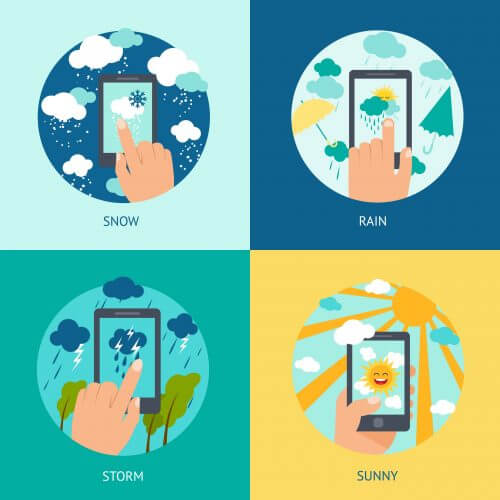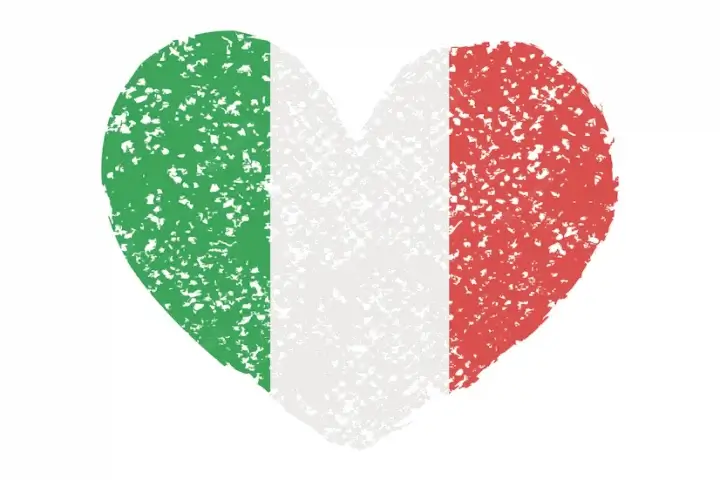“Che tempo fa?” Discussing the weather in Italian.
Well, we have some GREAT news for you today! Talking about the weather in Italian is one of the easiest things you can do! The expressions used are not incredibly complex and gaining mastery of them is merely a question of putting in the time to memorize the expressions and practice inserting them into conversation.
If you are curious about how to pronounce these new words, please check out our articles on Italian pronunciation here and here.
So, let’s dig in.
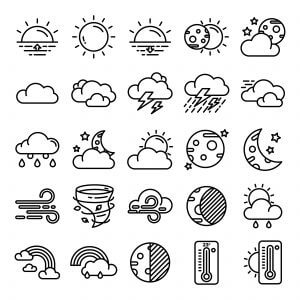
How do you say, “What’s the weather like today” in Italian?
There are two ways that you can say this?
The first is:
Che tempo fa oggi? (Literally, “What weather make today?”)
or, if you’re feeling fancy, you can say:
Com’è il tempo oggi? (Literally, “How is the weather today?”)
Expressions with “Fa”
The answer is easy! If it’s something that requires an adjective, just begin with “Fa.” Fa means “It does…”. And after Fa, you need only add the appropriate adjective.
caldo (hot), caldissimo (very hot), freddo (cold), freddissimo (cold), freddo (cold), fresco (cool)
This is the basic way to say “It’s cold” or “It’s hot” in Italian. But if you wanted to qualify things, you can add un po’ (a bit) or molto (very).
Expressions with “un po'” (a bit) and “molto.” (very)
Fa un po’ caldo. (It’s a bit hot.)
Fa un molto freddo. (It’s very cold.)
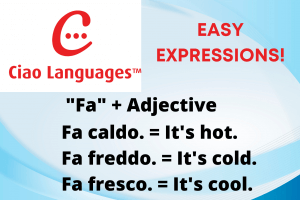
Expressions with “è” (It is)
It’s wonderful how Italians managed to boil the “It is……” down into ONE WORD: è. Remember that since there is an accent on the letter “e”, the pronunciation changes a bit. There is a minimal difference between e (and) and è (It is). è is shorter and with the lips pulled back almost into a smile. Try saying the English sound “AY” with a wide open grin but stop immediately and you’ll get the idea!
Here again, it’s simple. Just begin with è and follow it up with an adjective.
caldo (hot), caldissimo (very hot), freddo (cold), freddissimo (cold), freddo (cold), fresco (cool), afoso (hot and humid), secco (dry), nuvoloso (cloudy), tempestoso (stormy).
Try translating the following sentences into Italian to see if you’ve got the idea.
1) It’s hot today.
2) It’s humid today.
3) It’s very cold today.
Answers: 1) E’ caldo oggi. 2) E’ afoso oggi. 3) E’ molto freddo oggi.
If you answered correctly, Bravo!
Now, things start getting a bit more complex here. “è” is “It is…”, but Italians only use that expression with a restricted set of adjectives and definitely with noun phrases. In this latter case, they use the structure “C’è ….”(There is…).

For example, in English, we say ‘It’s sunny today,” whereas in Italian they would say something that would be literally translated as “There’s the sun today…”
C’è sole oggi (It’s sunny today)
C’è sole oggi
Here are some other expressions you can use after “C’è ….”
sole (sun), cattivo tempo (bad weather), bel tempo (nice weather), una tempesta (a storm), vento (wind), afa (hot humidity), neve (snow), pioggia (rain), una tromba d’aria (wind funnel), un acquazzone (a shower), tuono (thunder), la nebbia (fog), la foschia (mist), un diluvio (a downpour), un alluvione (flood)
Try translating the following sentences into Italian to see if you’ve got the idea.
1) There’s a storm.
2) It’s snowy.
3) It’s foggy.
Answers: 1) C’è una tempesta. 2) C’è la neve. 3) C’è nebbia.
Ok, buckle in because things are about to get really hard! We’ve seen “E’……” + adjective and “C’è” + adjective or noun, but now we are going to see the various verbs that Italians use to describe the weather.
Here are the verbs:
nevicare – to snow / piovere – to rain / tirare vento – to be windy / grandinare – to hail / gelare – to freeze / piovigginare – to drizzle / nevischiare – to sleet / schiarirsi – to clear up
In order to be able to use these verbs, you’ll have to know some Italian grammar – how to form the third person singular in the presente indicativo e presente continuo, for example, as well as other tenses for indicating the future, past, hypothetical cases etc. For the sake of simplicity, we’ll just use the presente indicativo here.
Nevica oggi – It’s snowing today.
Piove oggi. – It’s raining today.
Tira vento oggi – It’s windy today.
Grandina oggi – It’s hailing today.
Si schiarisce oggi. – It’s clearing up today.
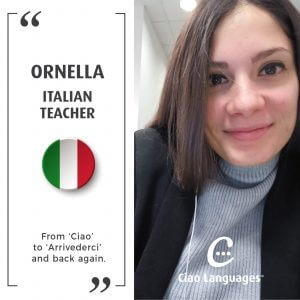
Expressions with “Che…..!!“
Italians will use the word “Che…” at the beginning of sentence to make an exclamation.
Che caldo oggi! – How hot today!
Just add an adjective or noun after “Che” and you’ll sound like an Italian making an exclamation.
Che brutto tempo! (What horrible weather)
Che bel tempo! (What horrible weather)
Che vento! (What wind!)
Che pioggia! (What rain!)
Idiomatic expressions involving the weather
Su questo non ci piove! = Literally, “On this it does not rain!” But what does it mean? It means, “There is no doubt about it.” Or, “We can all agree on that…”
Piovere a cantinelle = Literally, “It’s raining washing basins.” It’s the Italian expression equivalent to the English “It’s raining cats and dogs.”
C’è un caldo da morire. = Literally, “It’s deathly hot.” In other words, “It’s really hot.”
C’è un freddo cane. = Literally, “It is dog cold.” In other words, “It’s very cold.”
Piove sul bagnato. = Literally, “It’s raining on wet.” Basically, this is what you say when you have a problem that gets complicated by yet another problem on top of it. “When it rains, it pours.”
This brings us to the end of our article on how to discuss the weather in Italian. Obviously, there is a lot more to say about this topic, and, again obviously, knowing these things and being able to use them in a conversation are two entirely different things. What is needed its lots or practice and at Ciao Languages, with our staff of expert native speaking teachers of Italian, you’ll get lots of chances to try this stuff out in conversation and to learn how to use the expressions not just in the present, but in the past and future, as well. Contacting us is easy, just shoot as a message through our contact form, or if you want to speak to an actual human being, give us a ring at (949) 409 – 2122!
Copriti che fa freddo! (Cover up, it’s cold out!)
Contact Form
Contact us immediately for a quote.

